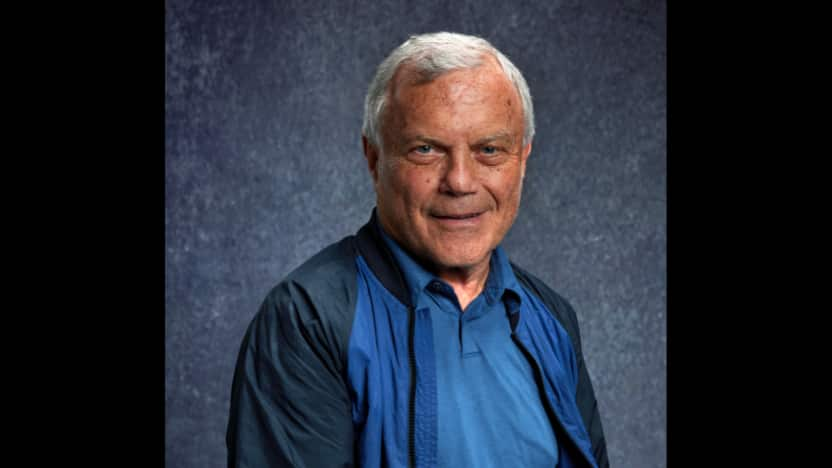Legendary adman Sir Martin Sorrell, at 80, remains in attack mode—betting on digital, data, and disruption as S4 Capital positions itself where client money flows: in tech, AI, and platform-driven growth.

Sir Martin Sorrell, the industry’s elder statesman, betting big on digital.
Few figures have shaped modern advertising the way Sir Martin Sorrell has. Back in 1985, he bought a small manufacturer of wire shopping baskets called Wire and Plastic Products (WPP) and turned it into the world’s largest advertising and marketing services group. For over three decades, he was the architect of WPP’s growth, acquiring agencies around the world and redefining how global brands communicated.
In 2018, after leaving WPP, Sorrell didn’t step back—he started again. At the age of 73, he launched S4 Capital, a digital-only advertising company built for an era dominated by data, platforms, and now AI. Today, S4 is a billion-dollar business working with some of the world’s biggest technology companies.
Sorrell remains as relentless as ever, with a reputation for speed, detail, and an instinct for where the industry is heading. In this conversation with BrandWagon Online, Sir Martin Sorrell, Chairman of the board of directors of S4 Capital, discusses AI’s impact, client strategies, and why he believes scale and ownership still define the future of agencies. (Edited Excerpts)
We generate approximately $1 billion in annual revenue, with nearly half of that coming from technology companies. Our largest relationship is with Alphabet (Google). Our second-largest is with the world’s biggest telecom company, which we can’t name due to NDA restrictions. Additionally, we collaborate with prominent companies such as Meta, Amazon, T-Mobile, Disney, Netflix, General Motors, BMW, and General Mills International. So yes, it’s true that a handful of major clients contribute a significant share of our revenue. But that’s not a weakness; rather, it’s a reflection of the scale and trust we’ve built with them over time.
What’s happening is that the biggest tech companies, what we call the MAGA7, are investing heavily—nearly half a trillion dollars annually—into capex around AI. That’s a huge shift from their earlier reliance on opex spending, which was traditionally more ad-driven. For us, it means a direct impact on how budgets are allocated, but we see it as an opportunity. If our clients are prioritising AI infrastructure, then our role is to position ourselves where the money flows—helping them get more efficiency, speed, and creativity out of those investments.
We think there are four core differentiators. First, we are digital-only. The advertising market globally is worth around a trillion dollars. Out of that, 60–70% is digital, and it’s growing between 10–20% annually. The rest—traditional media—is in decline, often by 10–15%, depending on whether there’s live sport or not. So, being 100% digital positions us in the fastest-growing part of the business. Second, we are data-driven. Data was always important, but in today’s AI-dominated world, it’s absolutely critical. Third, we focus on efficiency, which we capture in our tagline: “faster, better, cheaper, more.” “More” is about AI’s potential, but faster production cycles, better quality, and lower costs are equally vital. Finally, we operate under a single unified brand, unlike holding groups with multiple silos. That gives us consistency and agility.
Also Read: Attention CXOs: Culture, not code, will decide your future in the AI era
I’d argue the opposite. Having a deep relationship with a few major clients is an advantage. We focus on what we call “whoppers”—clients with over $20 million in annual revenue. We currently have nine of them. The goal isn’t to spread thin across dozens of smaller accounts but to deepen our partnerships with these global giants. Success in this business comes from scale and trust, and our concentrated client base is proof of that.
A lot of people like to throw around big figures, but I’d say our real investment in AI is our people—we spend about $550 million annually on talent. Many of those resources are already building and applying AI capabilities. We’ve developed around nine or ten proprietary products under our “Monts Flow” suite, all focused on simplifying workflows. Historically, agency-client relationships have been like a game of ping pong—briefs going back and forth endlessly. AI allows us to compress that cycle. For instance, we’re currently running an experiment with a major client: a commercial that would typically cost $2.5 million and take four months; we’re delivering in four weeks for $500,000. That’s the kind of step-change AI makes possible.
Free-to-air television is shrinking, even in markets like India. Younger audiences—and increasingly older ones too—are consuming content through platforms like Netflix, Amazon Prime, Disney+, and new entrants like JioStar. That’s why traditional broadcasters are under immense pressure, and you see leadership changes and consolidations across Disney, Paramount, Warner Bros. Discovery, and others. Globally, advertising is concentrated across six digital platforms: Google, Meta, Amazon, TikTok, Alibaba, and Tencent. These companies dominate because they have the scale, the capital, and the AI capabilities to keep investing at levels no one else can match.
Our strategy is organic growth, not aggressive M&A. We’re focused on scaling relationships, especially with technology clients. In terms of geography, every market matters, but North America remains critical, along with Canada, Mexico, and Brazil. In Europe, the big five—the UK, France, Germany, Italy, and Spain—are important, though challenged by slower growth. The Middle East, particularly Saudi Arabia, the UAE, and Qatar, is another major focus. Asia is the real growth story—India is hugely important, along with China, Japan, South Korea, Indonesia, Vietnam, Thailand, and Singapore. Africa is more volatile and fragmented, though countries like Nigeria and Ethiopia hold some potential. The principle is clear: choose markets where growth is visible and sustainable.
Also Read: The Rise of Data-Driven Influencer MarketingAbsolutely. We’ve already seen hints—IPG and Omnicom could come together, Havas may absorb Dentsu’s international operations, and WPP faces tough questions about whether to break up. If these shifts happen, the six large global holding companies could become four, or even three. Consolidation is inevitable in a slow-growth environment where scale matters.
The environment is tougher—growth is slower, geopolitical risks are higher, and efficiency is essential. Leaders need to be resilient and technologically literate. But I’d add one more thing: the difference between owners and managers. Owners take risks; managers avoid them. If you can combine ownership and management, that’s the sweet spot. At S4, we’ve tried to align the two. Ultimately, leaders who think and act like owners—who feel an emotional commitment to what they’ve built—are better placed to take tough calls. That’s what keeps companies moving forward in volatile times.
Empower your business. Get practical tips, market insights, and growth strategies delivered to your inbox
By continuing you agree to our Privacy Policy & Terms & Conditions
